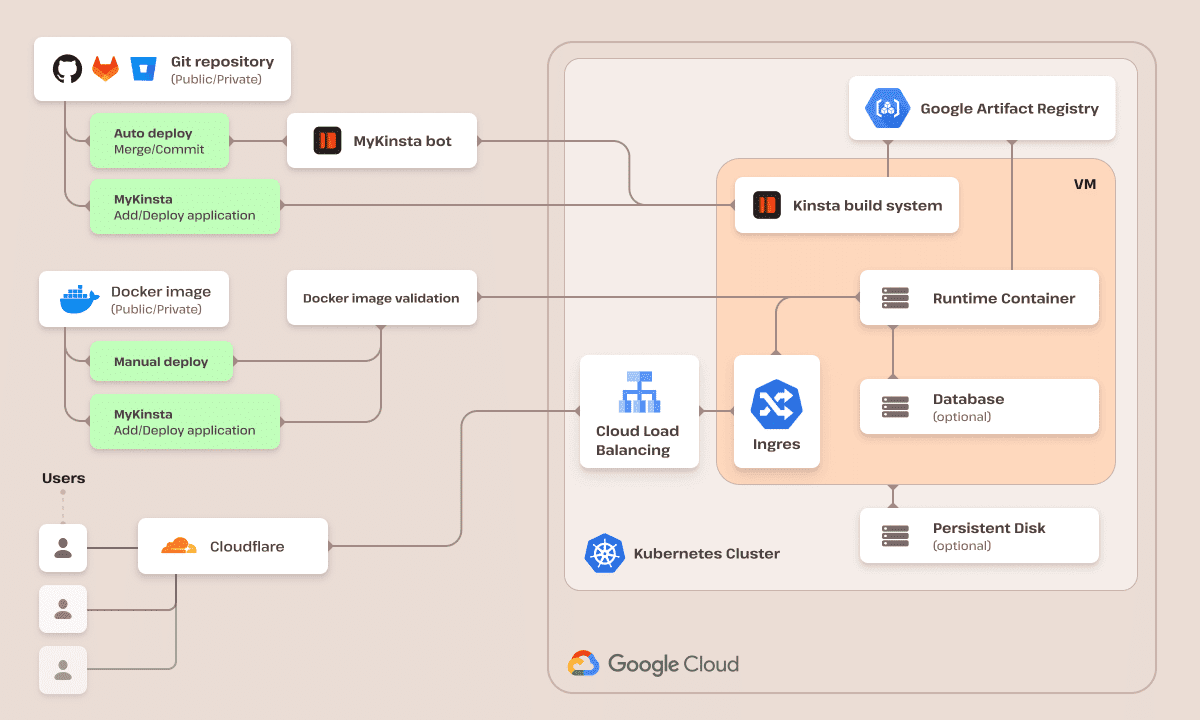Infrastructure
When you host your application or database with Kinsta, your projects run on Google Cloud Platform’s top-tier infrastructure. In this guide, we’ll dive a little into the details of our Application Hosting and Database Hosting infrastructure.

Git repository or Docker image
The application’s code can be stored within a public or private Git repository or Docker Image.
For private Git repositories, you can choose from any (or all) of the following:
Docker images must be built for Linux/amd64 architecture. For private Docker images you can choose from any (or all) of the following registries:
- GitHub (ghcr.io)
- GitLab (registry.gitlab.com)
- Docker Hub (docker.io)
MyKinsta add/deploy application
In MyKinsta, when you add an application, it connects to the Git repository or Docker image to retrieve the application.
MyKinsta bot
If you have an application using a Git repository with Automatic deployment on commit enabled within the application’s settings, the MyKinsta bot detects if you commit a change or merge to your repository; it then pulls the application from your Git service provider and deploys the updated version of the application.
Google Cloud Build
MyKinsta sends the application to Google Cloud Build to build an image of the application from the code. It knows what applications or modules to install for the application from the information in the Nixpacks, buildpacks or Dockerfile. The output is an image that can be turned into a container.
Google Artifact Registry
This stores the container images that are ready to deploy. Each application has a single image that can be used whenever it needs to be deployed.
Kubernetes cluster
The image from the artifact registry is pushed to the cluster. This is a virtual machine (VM) where multiple containers can run. The clusters are tuned to ensure the request from the artifact registry finds the right container, the containers are running, and they have the right resources. If there are any issues with a container, the application is redeployed to another container. We use cri-o v1.23.x on our infrastructure; however, this version is not static and may be upgraded as we upgrade different components in the stack.
Our Kubernetes infrastructure supports a multi-tenant setup, where each application runs in its own containerized environment. Network isolation and multi-layer virtualization ensure security and prevent unauthorized access between applications. This design provides you with a reliable and secure hosting platform, enabling you to focus on your core business while we handle the underlying infrastructure. We deploy at least one cluster per region, with the potential for additional clusters based on the number of applications in each region. This system ensures optimal resource allocation and scalability to meet the growing needs of our clients.
Cloudflare
When a visitor accesses the website for an application, it first accesses Cloudflare, which knows which cluster hosts the website. It then sends the access request to the correct cluster.
Currently, for Application Hosting and Database Hosting, Cloudflare includes the default firewall rules, the default DDoS protection, and other defaults.
Cloud load balancing
Each cluster has a load balancer that receives the access request from Cloudflare and randomly pushes a VM worker node.
Ingress
The VM worker node receives the request on the Ingress system, which knows which container is responsible for the hostname being requested. The Ingress system sends the request to the correct container, and if the container has a database attached, it communicates with the database and sends a response on the same route.
Virtual Machines (VM)
A virtual machine (VM) can hold multiple containers and multiple databases.
Containers
Each container or application can have multiple copies on the VM. In this case, the Ingress system knows this and randomly sends through one of the copies of the same container.
Persistent storage
You can add persistent storage to a web process or background processes. This adds a storage volume that is attached to the VM (virtual machine) for your application and retains data even if the application is restarted or redeployed.